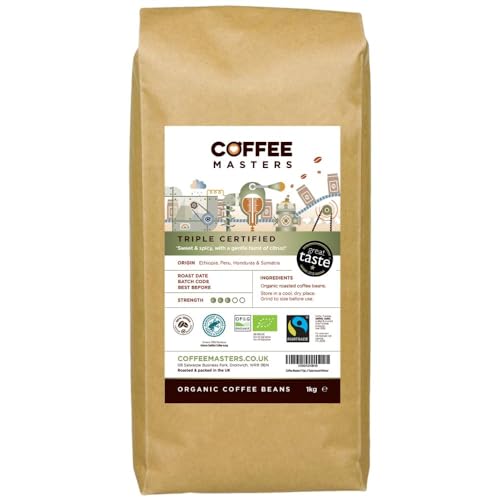What To Look For To Determine If You're In The Right Place For Coffee Bean

The Benefits and Side Effects of Coffee Beans
Coffee beans offer a range of health benefits, such as improved cognitive function and a lower risk of heart disease. However, consuming too many beans can cause adverse effects, such as sleep problems and anxiety.
The flavor of coffee is affected by the terrain, elevation, and cultivation methods. The plant's species can also affect the taste.
Origin

Coffee beans are the seeds of a tropical evergreen tree. They are grind and roasted to produce the most widely consumed coffee beverage, which is enjoyed throughout the world. Coffee is the world's third most loved beverage and is among the most profitable commodities. It is well-known for its energizing effects, due to the alkaloid caffeine.
The most well-known origin story of coffee is of an Abyssinian goat herder named Kaldi. He noticed his animals became more energetic after eating berries of certain plants. He found the berries to be stimulating and began cultivating the plant.
In the 16th century, coffee was transported eastwards to the Arabian Peninsula, where it was cultivated in the Yemeni area. The first coffee houses were opened. These gathering places were opposite to taverns in Europe and were geared towards fast-paced and deep thinking.
Today the majority of world's coffee production comes from two varieties of plant called Arabica and Robusta. They are most productive in the Bean Belt region which is a strip of land between the Tropic of Cancer & Capricorn.
Types
There are a variety of coffee beans, and each type is distinct in its flavor profile. The region where coffee beans are grown can also have an impact on their flavor. For instance, Ethiopian coffee is known for its floral and citrus notes, while Colombian beans are full-bodied and have a balanced acidity.
The coffee beans are gathered in various methods, and some are processed to enhance their flavors. Some are dried and then roasting, whereas others are frozen, and then ground later. They may also be polished to remove the silver skin that covers the bean, which is known as depulping. The beans are later sorted and rated according to weight and size, and any defects removed either manually or by machines.
Contrary to the Arabica plant, Robusta plants can grow at lower altitudes and are more resistant to pests. They also tend to contain more caffeine than Arabica beans, and are commonly used in instant coffees or blends. A increasing number of coffee drinkers are discovering the unique flavor and superior single origin coffees.
Flavor
Coffee beans can be infused in a variety flavors to add new dimensions to desserts, drinks, and food recipes. The type of beans that are best for a particular recipe depends on the flavor profile it is intended to have and the manner in which it will be used.
The coffee bean is a seed that is a source of pollysaccharides as well as other proteins, sugars, lipids, and minerals. The seed is covered by a silverskin, which is removed during roasting. When the seeds are heated they trigger a series of reactions that create their aroma, flavor and color.
Natural coffee flavors are highly sought-after by purists. However, it is also possible to add flavor to the coffee beans that have been roasted using manufactured flavors. To enhance the flavor of a batch the roaster sprays flavorful oil onto the beans. The flavored oil will then be added to the beans to ensure it is evenly distributed. The beans are then chilled, ground and packaged. The beans that are flavored can be blended into a cup coffee or consumed as a snack.
Health benefits
Coffee beans are a good source of caffeine, a potent stimulant that can boost mood and increase energy levels. coffee beans unroasted www.coffeee.uk contain phenolic compounds, which are antioxidants that protect cells from injury. According to the National Institutes of Health, these compounds are associated with a lower risk of heart disease and cancer.
The seeds of the coffee plant are located inside the fruit, which resembles an apple. Usually, the fruit has two seeds, positioned flat against each other. Certain fruits contain only one seed. They are referred to as peaberries. Peaberries make a weaker, less flavorful cup.
Roasting coffee beans alters their flavor, making them more pleasing to the palate. Roasting coffee beans makes them easier to digest by the body.
Coffee beans contain phenolic components that block the formation of glucose in the liver, and help lower cholesterol levels. They also may reduce the risk of non-alcoholic fatty liver cirrhosis and non-alcoholic liver disease. Coffee beans are a rich source of potassium, riboflavin and B vitamins, and are also rich in fiber.
Side effects
Coffee seeds are roasted, then blended into a drink that is popular. Coffee consumption is associated with a reduced risk of type 2 diabetics and liver disease. However, the caffeine in coffee can cause adverse effects such as jitters, high blood pressure, and heartburn for some people. Green coffee bean extract, which is a non-caffeinated option has been found to provide some of the same benefits without the negative side effects of caffeine.
Coffee beans are a rich source of volatile and nonvolatile chemicals which protect them from oxidation, insects, and a variety of diseases. These chemicals also enhance their flavor. Nonvolatile compounds create a wax-like cover on the surface of coffee beans. This covering deters many insects from consuming coffee beans and assists the beans to retain moisture.
The fatty acids present in coffee beans are converted to energy when they are roasted. This energy can enhance mental performance. It also aids in the release of adrenaline, which is a hormone that prepares the body for physical exertion. Additionally the chlorogenic acid contained in green coffee beans might reduce fat absorption and slow down sugar release through the digestive tract.
